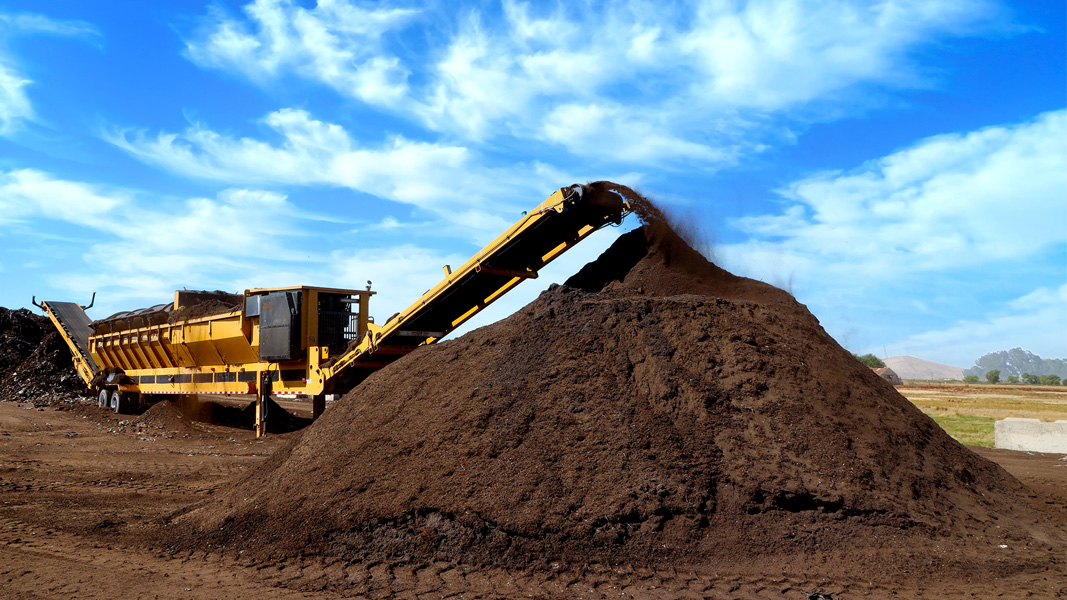Top: Recology makes OMRI-certified compost at 6 of the 8 composting facilities it owns and operates, including at Recology Ostrom Road Organics, near Wheatland, CA. Photo by Larry Strong, courtesy of Recology
California Assembly Bill 1201, signed into law in October 2021, requires products that are labeled with the term “compostable” or “home compostable” be designed to be associated with the recovery of desirable organic wastes that are collected for composting and must be an acceptable compost feedstock for organic agriculture under the U.S. Department of Agriculture’s (USDA) National Organic Program (NOP). The NOP does not include certified compostable packaging as an allowed compost feedstock. In August 2023, BPI petitioned the NOP to reconsider that classification. In October, the NOP instructed the USDA’s National Organic Standards Board to review allowed feedstocks for compost, including what is being requested in BPI’s petition.
AB 1201 includes a requirement that CalRecycle, the state regulatory agency that will enforce AB 1201, go through a public process on or before January 1, 2024, to determine whether it would be feasible to separate the collection of products that are not acceptable compost feedstocks under the NOP from collection of organic wastes that are acceptable compost feedstocks under the NOP. The agency’s term for two separate processing lines at a composting facility is “bifurcation.” The law further states that “if the department determines that such bifurcation is feasible and would enable efficient processing by solid waste processing facilities, the department shall adopt regulations on or before January 1, 2026, to establish a bifurcated approach, and products that are not collected for the purpose of recovering organic waste that is suitable for use in organic agricultural applications shall comply with the department’s regulations and are not subject to the requirements of this subparagraph.” In other words, if CalRecycle determines it would be feasible to establish a separate collection system for products not appropriate as an input for compost used in organic agriculture, it would have to adopt requirements specific to such products, and the NOP requirement would not apply to those products.
On November 1, CalRecycle held a public meeting to take comments on the bifurcated approach; a discussion paper was distributed ahead of the meeting. The agency emphasized that the meeting was focused on bifurcated processing of source separated streams — with and without compostable packaging — and not collection. CalRecycle presented findings of a survey it conducted in June 2023 of 34 mixed materials composting facilities (ones taking feedstocks that include food and green waste); 24 facilities responded. In California, compost that is suitable for use in organic crop and livestock production is required to be registered as an Organic Input Material (OIM) with the California Department of Food and Agriculture (CDFA). The survey found that 63% of the 24 survey respondents noted their composts were registered as an OIM.
Facilities surveyed were asked to rank their top three concerns related to accepting plastic and plastic-containing materials. The top three concerns were:
- “Physical contaminants affect quality/marketability” — 54% listed this as a concern; 33% ranked it as the top concern.
- “Losing compost product certifications (OIM or OMRI) and resulting impacts on marketability” — 38% listed this as a concern; 21% ranked it as the top concern.
- “Certified compostable plastics are indistinguishable from traditional fossil-based plastics” —38% listed this as a concern.
The survey also asked which paper and fiber materials composting facility operators accept and process into finished compost. Eighty-three percent of respondents said they accepted uncoated paper/paperboard; 29% accept bamboo fiber; 21% accept wax-lined paper/paperboard (e.g., hot or cold cups); 17% accept sugarcane/bagasse fiber; and 13% accept clay-coated paper/paperboard (e.g., cereal boxes).
When asked if it would be feasible to process two separate organic waste streams to keep organic wastes that are acceptable compost feedstocks under the NOP separate from products that are not acceptable, 58% noted it would not be feasible. Twenty-five percent responded “yes,” and 12% said it would be feasible, but would be expensive, and contamination would still be a concern. Seventy-nine percent of respondents stated that adding the capacity to process a separate stream would increase their operational costs by more than 20%, noting they would need to double processing capacity to have two streams, because there cannot be any cross contamination. They further stated that “CDFA and OMRI require equipment to be cleaned before handling organic material which is very time consuming and creates inefficiencies in an operation.”
CalRecycle’s takeaways from the survey, which will be considered as it drafts the AB 1201 implementation regulations, are:
- While markets clearly exist for compost that incorporates uncoated paper and paperboard products, it is not clear that there is a market for compost that intentionally incorporates plastic or plastic-containing products.
- Composting facilities have already made significant investments in operational capacity and labor to implement SB 1383 (the landmark law to divert organics from disposal). Adding another organic stream for them to process will significantly increase the amount of additional investment needed.
- Bifurcated collection of products would not enable the current solid waste processing infrastructure to efficiently process and recover products that are not allowable compost inputs under the NOP.













